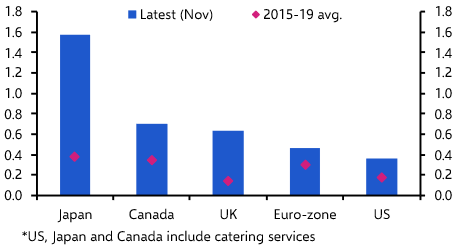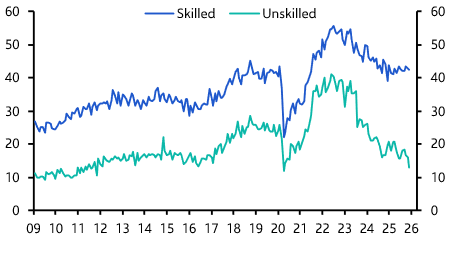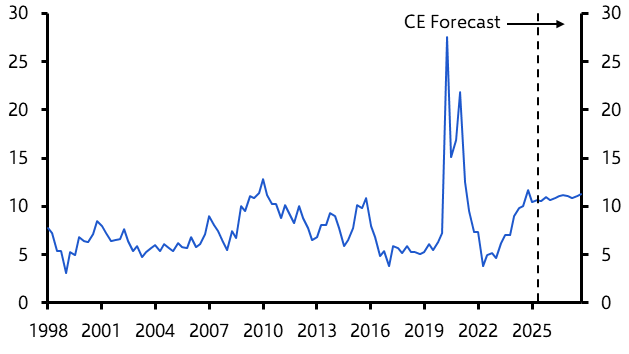It’s energising would-be trustbusters in the White House. It’s dragging UK supermarket bosses before Parliament. And, according to the IMF, it’s played a role in driving inflation across Europe.
Accusations of ‘greedflation’ – the idea that surging consumer prices are caused by companies seeking to increase profits – have triggered an understandably impassioned debate across advanced economies. Consumers are struggling to keep up with the biggest jump in inflation in four decades. And with aggressive monetary tightening yet to produce decisive results, focus has intensified on companies and their pricing behaviour.
But, as we argued in an in-depth report last week, the debate around ‘greedflation’ has been at best incomplete and at worse fundamentally misconceived. This is a potentially dangerous distraction from the priority of tackling the root causes of inflation, and one that could lead to reactionary policymaking that only intensifies an already-imbalanced supply-demand situation.
Simon MacAdam, the report’s author, discussed the ‘greedflation’ debate on our Weekly Briefing podcast this week, and will be joining a Thursday Drop-In to take the discussion forward and answer your questions. Register here.
Understanding the data
Charges of ‘greedflation’ have leaned on data showing profits within GDP deflators, which measure price changes in an economy, rising over the past year. This is the “smoking gun” cited by, among others, the IMF. But this is also a misinterpretation of how corporate profits are treated within a country’s national accounts.
This profit measure includes much more than company profits. Imputed rents from property, for example, are also included. The rise in the value of housing in advanced economies over the past two years represents a flow of income to property owners. Since this income derives from capital rather than labour, it is reflected as a rise in profits within the national accounts. In other words, this has nothing to do with the profits of firms or the pricing power of the businesses at the heart of the ‘greedflation’ row. Stripping out these imputed rents, and other non-profit related items, such as the income of the self-employed and capital depreciation costs, shows that the rise in inflation attributed to profits is smaller.
Another point of confusion surrounds what has actually been happening to companies’ profit margins and how this compares to what usually happens at this point of the economic cycle. In periods of economic weakness, profit margins tend to get squeezed. This is because firms are more responsive than workers to weakening demand and adjust their prices accordingly. However, this is not what has happened over the past year. Instead, firms have been able to maintain their margins, despite the fact that input costs have risen and economic growth has been weak in the case of the US and negative in key economies in Europe.
We estimate that inflation in advanced economies has been 2-3 percentage points higher as a result of firms maintaining their profit margins. But – crucially – this does not support the accusation that companies have expanded margins and thereby fuelled inflation. Of course, the margins of some firms – particularly in energy – have increased substantially. But in aggregate firms have protected margins, not padded them.
Muddling symptoms and cause
This gets to the heart of the misconception behind the idea of ‘greedflation': it is fundamentally about the distributional consequences of inflation rather than the underlying cause. The key point here is that firms have been able to pass on higher input costs to consumers rather than having to absorb them in their margins. This reflects the overall strength of aggregate demand relative to supply, and it is this that is driving inflation.
An optimistic interpretation of what follows is that companies respond to the cooling demand caused by tighter monetary policy by allowing those higher costs to be absorbed in their margins, and that this allows consumer prices to adjust more quickly.
But politicians are facing pressure to respond to public anger about inflation. They need to tread carefully – this shouldn’t be a reason for interventionist policies like price caps, as some are calling for. These would serve to hamper supply and intensify the inflation problem.
Meanwhile, central banks must focus on tackling the root cause of inflation, which is an imbalance between aggregate demand and supply. As I’ve noted before, judging the extent to which the supply-side has been fundamentally damaged by the pandemic – as opposed to temporarily distorted – makes calibrating the appropriate policy response extremely difficult.
The fact that monetary policy operates with a lag – and that around half the effect of monetary tightening so far has yet to be felt – adds to the challenge. The prospect that a squeeze in profit margins will help to bring down inflation offers some hope to central banks. But for the time being they need to focus on restraining demand. On that front, the likelihood is that they’ve more work to do.
In case you missed it:
- It’s payrolls week and Olivia Cross from our US team outlined our forecast for a 250,000 increase in jobs in June – down sharply from May but still fairly resilient.
- The latest reading of our China Activity Proxy, a more accurate read of underlying growth than official data, shows the recovery stagnating.
- Bradley Saunders from our Markets team explained why, in a change from the first half, “safe” assets will have a better rest of the year than their risky counterparts.





